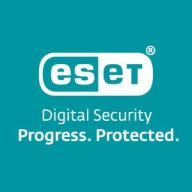

ESET Endpoint Protection Platform and Microsoft Defender Vulnerability Management are prominent competitors in the security solutions sector. Microsoft Defender holds an advantage with its extensive feature set, though ESET excels in pricing and support.
Features: ESET Endpoint Protection Platform provides robust protection with features like advanced malware detection, customizable security controls, and a lightweight design to minimize resource usage. Microsoft Defender Vulnerability Management integrates thorough threat intelligence, vulnerability assessments, and advanced analytics for a comprehensive security approach.
Room for Improvement: ESET could enhance its integration with other platforms and expand its analytics capabilities. It may also benefit from more advanced threat intelligence. Microsoft Defender, while feature-rich, could improve user interface simplicity and reduce dependency on integration complexity. It would also benefit from pricing adjustments to enhance appeal.
Ease of Deployment and Customer Service: ESET offers straightforward deployment with minimal technical assistance, complemented by responsive customer service. Its simplicity contrasts with Microsoft's more complex installation due to integration needs, though Microsoft provides strong support channels to assist users through the process.
Pricing and ROI: ESET Endpoint Protection Platform is cost-effective, providing a high ROI through lower initial setup costs. Microsoft Defender Vulnerability Management involves a higher initial investment, yet offers significant ROI via its robust feature set and enhanced security outcomes.
As a Microsoft partner, we receive significant discounts, making the solution affordable for us.
Normally, I cannot give a ten for support of all brands, as it is not always possible to get full support from companies.
They are sometimes responsive, however, often issues cannot be reproduced on their end, making it challenging.
My team raised multiple support tickets for the product, and we were able to get responses from Microsoft support team.
Their response time and skill set are both good.
In terms of scalability, I can rate it eight or nine out of ten.
It is scalable; I evaluated the product and decided to use Defender on over 700 of our company servers.
In terms of stability, I can rate it at nine out of ten.
It is very resource-intensive, consuming a lot of memory and CPU.
There are compatibility issues occasionally arising with false positives when other security tools are not whitelisted in Microsoft Defender.
I would rate the overall stability as an eight.
A lightweight version of ESET might be beneficial as many of our clients have older CPUs and RAM.
The product is not stable; it often uses excessive memory and CPU, which makes it slow.
A vulnerability I patch within 15 minutes takes 24 additional hours for an update.
A potential improvement could be the introduction of a more advanced AI agent, possibly a large language model with better performance than the existing Microsoft Copilot.
The pricing of ESET Endpoint Protection Platform is a bit high compared to other competitors.
For non-partners, however, the cost could be seen as higher, between seven to ten.
Overall, every organization wishes for cheaper options, but we look at the security side as well, so we are good for now.
The pricing is reasonable, and it's included in the whole Microsoft E5 bundle, so it's all-inclusive.
The primary purpose is to protect computers from viruses and ransomware.
Microsoft Defender Vulnerability Management is versatile and assesses vulnerabilities, providing detailed information on CVEs, their categories, and exploit statuses.
Microsoft Defender Vulnerability Management provides regular advisories and recommendations that help improve our security posture.
The most valuable aspect is the kind of assessment results I get, and the recommendations provided in Microsoft products really help in taking care of the resources.


ESET Endpoint Protection Platform (EPP) is a cybersecurity solution designed to protect businesses of all sizes against a wide array of cyber threats. Its advanced technologies and user-friendly interface provide robust security for endpoint devices, such as desktops, laptops, and mobile devices, without compromising performance. ESET's approach combines multiple layers of protection, including traditional signature-based detection with advanced heuristic analysis, behavioral monitoring, and machine learning, to effectively counter both known and emerging threats.
ESET's Endpoint Protection Platform is based on a multi-layered defense strategy, which utilizes various technologies like cloud-based scanning, network attack protection, and exploit blockers. This strategy ensures solid protection against malware, ransomware, phishing attacks, and advanced persistent threats (APTs), offering businesses peace of mind regarding their digital security. ESET's platform protects computers, mobile devices, file servers and virtual environments. It’s available as a standalone product and as a part of a wider enterprise cybersecurity bundle, ESET PROTECT Enterprise, which also includes file server security, disk encryption, a cloud sandbox and EDR.
ESET PROTECT Advanced
The ESET PROTECT Advanced provides best-in-class endpoint protection against ransomware & zero-day threats, backed by powerful data security.
Performance and Compatibility
ESET is widely acclaimed for its light system footprint, ensuring that endpoint protection does not come at the expense of performance. This efficiency is crucial for maintaining operational productivity without sacrificing security. Moreover, ESET's solutions are compatible with a wide range of operating systems, including Windows, macOS, Linux, and Android.
Centralized Management
ESET Endpoint Protection Platform is managed via ESET Security Management Center, a centralized management console that provides real-time visibility into on-premise and off-premise endpoints. This simplifies the administration of security policies, streamlines the detection and response processes, and provides detailed reporting capabilities, making it easier for IT professionals to maintain a secure and compliant IT environment.
Microsoft Defender Vulnerability Management enables organizations to identify vulnerabilities, manage patches, and fortify threat detection. It offers endpoint assessments, cloud incident management, and dynamic security through Microsoft's Security Scorecard integration.
Organizations leverage Microsoft Defender Vulnerability Management for advanced threat detection and response. It provides robust tools for vulnerability assessment and cloud incident management, integrated with Microsoft's Security Scorecard to enhance dynamic security profiling. Key features include automatic patch deployment, security configuration management, and seamless integration with Microsoft platforms, benefiting both on-prem and cloud environments. Organizations can track vulnerabilities with severity-based reports, helping manage outdated software and minimizing threat exposure.
What are the key features of Microsoft Defender Vulnerability Management?In healthcare, Microsoft Defender Vulnerability Management helps manage compliance with health regulations, while in finance, it aids in securing sensitive data from cyber threats. Manufacturing sectors benefit from its patch management, keeping operational technology systems less vulnerable to disruptions.
We monitor all Advanced Threat Protection (ATP) reviews to prevent fraudulent reviews and keep review quality high. We do not post reviews by company employees or direct competitors. We validate each review for authenticity via cross-reference with LinkedIn, and personal follow-up with the reviewer when necessary.